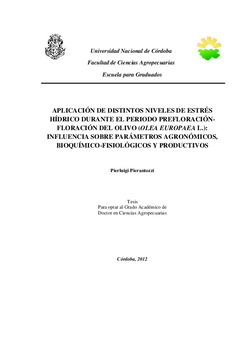| dc.contributor.advisor | Maestri, Damián M. | |
| dc.contributor.author | Pierantozzi, Pierluigi | |
| dc.date.accessioned | 2015-03-26T17:15:38Z | |
| dc.date.available | 2015-03-26T17:15:38Z | |
| dc.date.issued | 2012 | |
| dc.identifier.uri | http://hdl.handle.net/11086/1767 | |
| dc.description | Tesis (Doctor en Ciencias Agropecuarias)--UNC- Facultad de Ciencias Agropecuarias, 2012. | es |
| dc.description.abstract | El objetivo del trabajo fue estudiar la influencia del aporte hídrico durante el período pre-floración - floración (mediados de Junio - final de Octubre) sobre parámetros agronómicos, bioquímico-fisiológicos y productivos en las dos variedades (Arbequina y Manzanilla) de olivo (Olea europaea L.) de mayor difusión en la provincia de Córdoba. Se analizó el efecto de tres niveles de riego en déficit, equivalentes al 75, 50 y 25 % de la evapotranspiración del cultivo (T75, T50 y T25, respectivamente), comparándolos con un tratamiento sin aporte de agua de riego (T0) y otro sin restricción hídrica (100 % de la evapotranspiración del cultivo, T100), durante dos ciclos de cultivo consecutivos. La restricción hídrica estuvo asociada a una serie de respuestas bioquímico-fisiológicas a nivel foliar, las cuales pueden interpretarse como mecanismos de adaptación al déficit hídrico. El déficit hídrico también se relacionó con un incremento en la concentración de aldehído malónico, y con una disminución de la concentración de pigmentos fotosintéticos, de la conductancia estomática y de la tasa de fotosíntesis neta. La restricción hídrica limitó severamente el crecimiento de brotes y el desarrollo floral durante el primer ciclo de cultivo analizado. Se observó una interacción significativa entre tratamiento de riego x ciclo de cultivo en casi todos los parámetros analizados. El déficit hídrico estuvo asociado a un acortamiento y un retraso de la plena floración. La relación número de frutos / número de flores fue significativamente más baja en los tratamientos T0 y T25 indicando que la disponibilidad de agua, además de limitar el desarrollo floral, también provoca una disminución en el cuajado de frutos. El aporte hídrico tuvo una marcada influencia sobre la productividad de los árboles; el efecto compensatorio no fue suficiente para equilibrar las producciones logradas en los diferentes tratamientos de riego. En relación al contenido y la composición del aceite y teniendo en cuenta el periodo de aplicación de la restricción hídrica, las diferencias observadas entre los tratamientos de riego deben atribuirse principalmente a su influencia sobre la carga frutal y maduración de los frutos, las cuales afectan la tasa de acumulación de aceite y su composición en ácidos grasos, como así también el contenido fenólico de los mismos. | es |
| dc.description.abstract | The aim of this work was to study the influence of water stress during the preflowering
- flowering period (middle June – ending October) on agronomic, biochemicalphysiological
and productive parameters in the two olive (Olea europaea L.) varieties
(Arbequina and Manzanilla) most widespread in Cordoba province. In two consecutive
growing seasons, the effect of three deficit irrigation levels, equivalent to 75, 50 and 25%
of crop evapotranpiration (T75, T50 and T25, respectively) was analyzed comparing them
with a treatment without irrigation (T0) and one without water stress (100% crop
evapotranpiration, T100). Deficit irrigation was associated with some leaf-level
biochemical-physiological responses, which can be interpreted as adaptation mechanisms
of olive to water deficit. Water stress was also associated with increased malondialdehyde
concentration, and decreased levels of photosynthetic pigments, stomatal conductance and
net photosynthesis rate. Water-deficit conditions severely limited shoot growth and floral
development. During the first growing season, a delayed onset of full bloom and a shorter
flowering period were observed in the least irrigated treatments. The number of fruits /
number of flowers ratio was significantly lower in treatments with higher water restriction
(T0 and T25) indicating that water stress also causes a decrease in fruit set. Water supply
had a marked influence on tree productivity: considering both Arbequina and Manzanilla
varieties, the average fruit yield in T100 was 8.5 times higher than that obtained in T0. In
relation to oil content and composition, and taking into account the period in which water
restriction was applied, the differences among irrigation treatments should be mainly
attributed to their influence on crop load and fruit maturation, which affected the rate of oil
accumulation, as well as the fatty acid composition and the phenolic content of fruits. Data
obtained in this work prove a marked water deficit during the winter-spring period in the
olive growing area in central Argentina. The lowest yields obtained under total or severe
water deprivation brings out the importance of irrigation during the pre-flowering -
flowering period with a view to maximize the olive productivity. | en |
| dc.format.extent | 107 h. : ilustración color | |
| dc.language.iso | spa | es |
| dc.rights | Atribución-NoComercial-SinDerivadas 2.5 Argentina | * |
| dc.rights.uri | http://creativecommons.org/licenses/by-nc-nd/2.5/ar/ | * |
| dc.subject | Olivo | es |
| dc.subject | Olea europaea | es |
| dc.subject | Floración | es |
| dc.subject | Fisiología vegetal | es |
| dc.subject | Estrés hídrico | es |
| dc.title | Aplicación de distintos niveles de estrés hídrico durante el periodo prefloración-floración del olivo (Olea europaea L.) : influencia sobre parámetros agronómicos, bioquímico-fisiológicos y productivos | es |
| dc.type | doctoralThesis | es |





